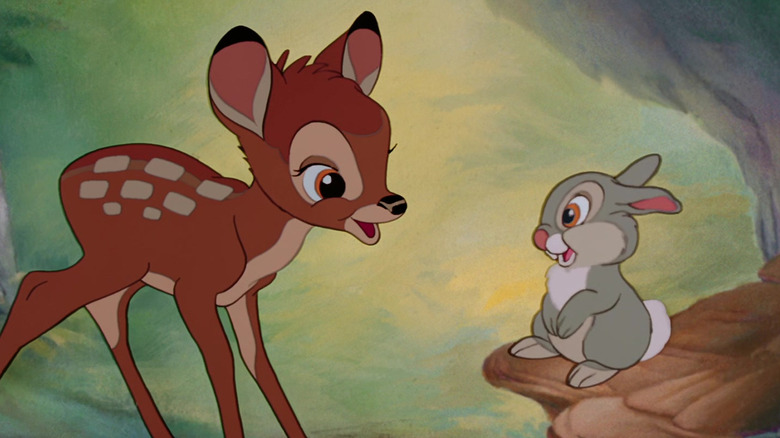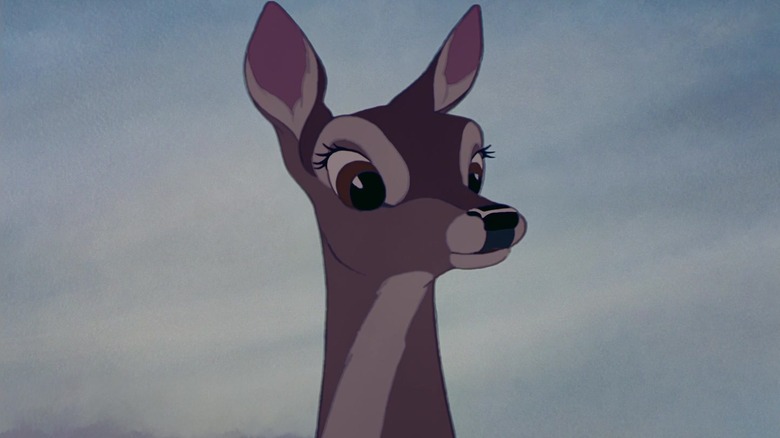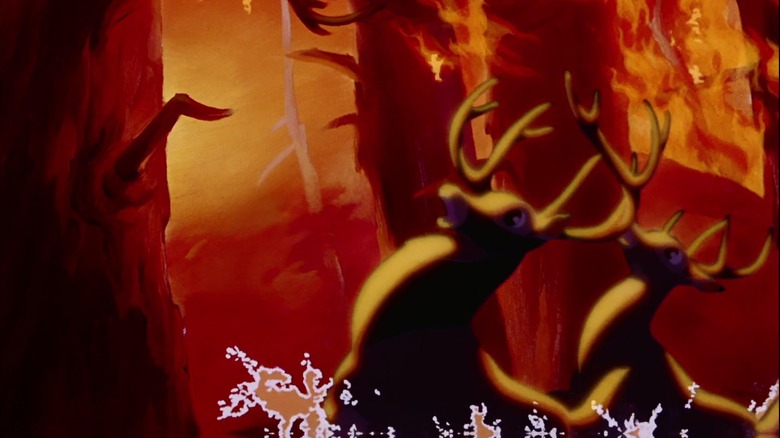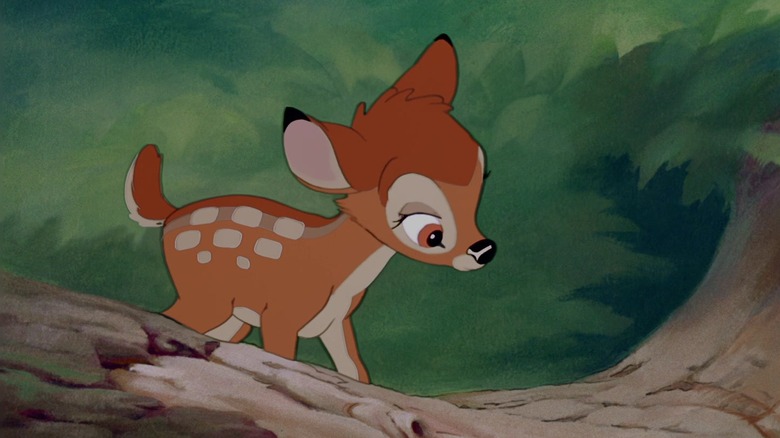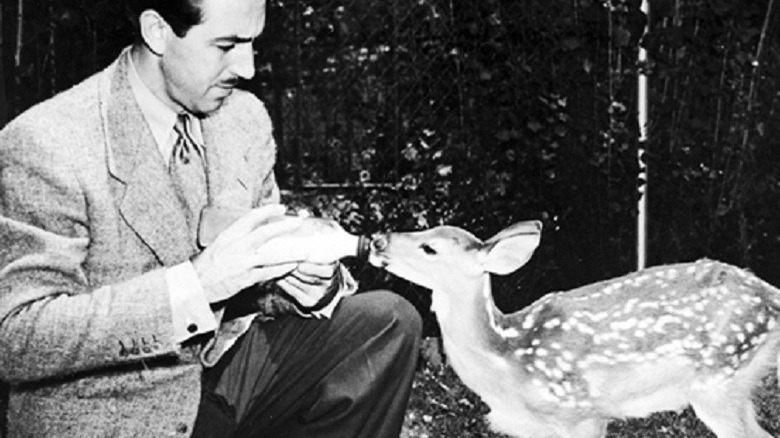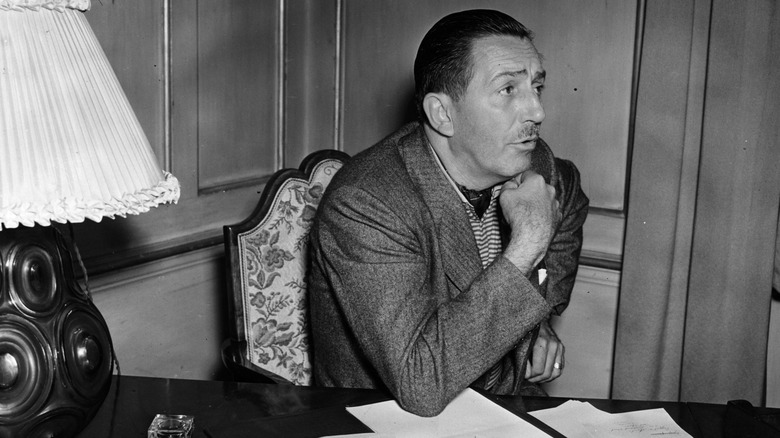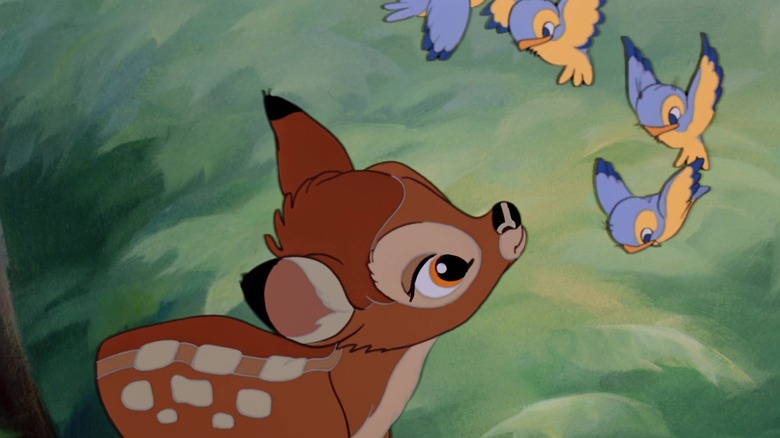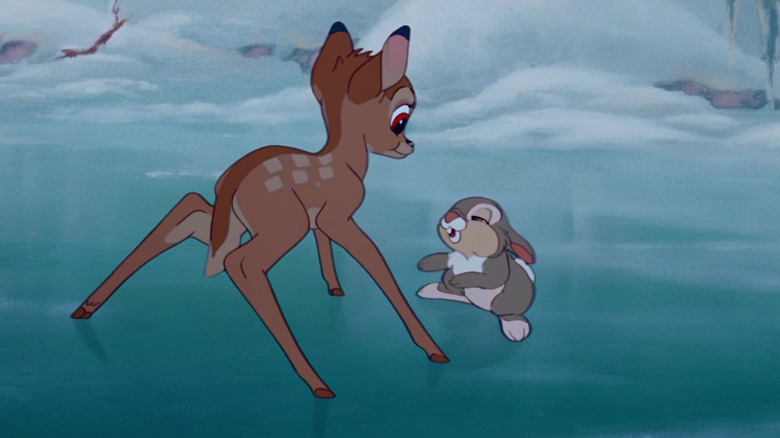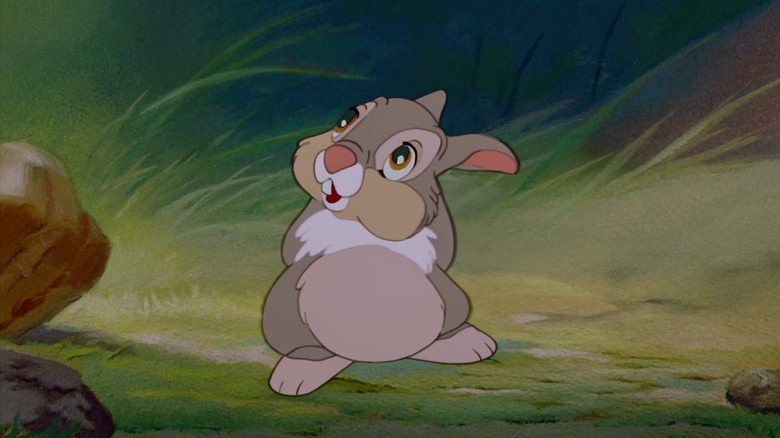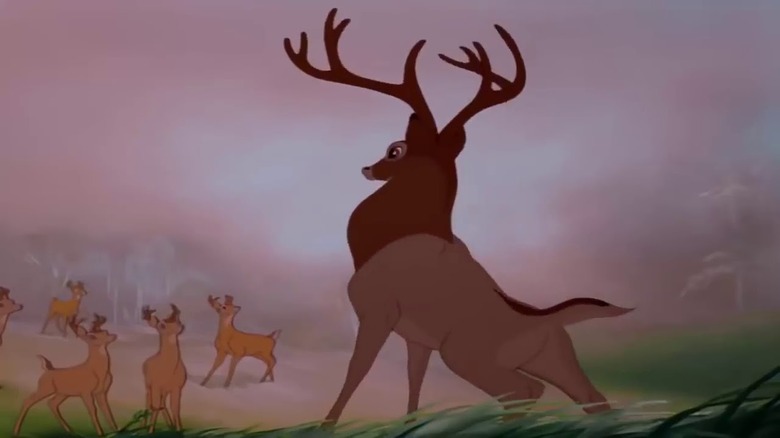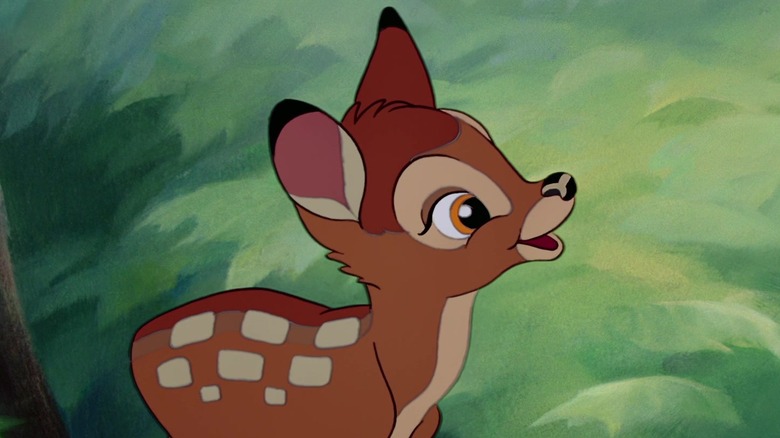The Untold Truth Of Bambi
After Disney made the leap from shorts to feature films with "Snow White and the Seven Dwarfs" in 1937, the studio appeared to be on an unstoppable run of films in the period that later became known as "The Golden Era" (via BFI). Demonstrating its ability to combine unforgettable characters with exquisite imagery, Disney cemented its legacy and produced some of the greatest animated films of all time in this period of immense creativity and experimentation.
While 1940's "Fantasia" was an experimental film of a different kind, two years later, Disney made another bold leap with the release of "Bambi" — a film that took a more realistic approach in terms of style and storytelling, albeit with the anthropomorphic animals that the studio was becoming known for. Telling the story of the titular fawn prince, the film follows Bambi from birth through the changing seasons, as he experiences all of the wonders of the forest, and the unseen dangers of those who come into his home to hunt.
Charming audiences for more than 80 years, "Bambi" marks the pinnacle of Disney's glittering Golden Era, and sits on the precipice of a period of great change and transition for the studio as it managed the impact of World War II. As both an unforgettable coming-of-age story, and a fable on the importance of caring for the environment, the influence of "Bambi" is something that is still felt keenly today. Here are some of the things you might not know about the Disney classic.
The darkest scene in the film was meant to be even more graphic
Disney films have always managed to carefully balance a light-hearted tone with more emotional and impactful moments — one of the many reasons these films speak to audiences of all ages. While Disney films are not just aimed at a younger audience, the appeal of the cute characters and colorful animation undoubtedly speaks to children.
Depicted with many childlike quirks, and an endearingly innocent personality, children will immediately relate to Bambi — perhaps seeing something of themselves in the way he plays and learns under the watchful eye of his mother. All of this makes the shocking death of Bambi's mother even more impactful, with his innocence snatched away in a moment, showing many young watchers what is perhaps their first experience of death.
Despite the fact the incident happens off-screen, it is still a deeply traumatic moment that potentially could've been even more graphic. Disney storyboards of a deleted scene show not only Bambi's mother getting shot, but also her lifeless body following the incident (via World of Reel). Showing the reality of life in the forest was important to Walt Disney in particular, however, his daughter Diane begged him to save Bambi's mom. In an interview in 2006, Disney biographer Neal Gabler detailed how Walt responded that he felt it was necessary to show all the complexities and conflicts in life, and he couldn't always provide an easy or happy ending (via Box Office Mojo).
The book it is based on was banned in Germany
When it came to seeking inspiration for their animated films, Disney often looked to classic literature and fairy tales, with four of the five films in the period from 1937 to 1942 (all except "Fantasia") being based upon existing works. After purchasing the rights to Felix Salten's 1923 novel, "Bambi, a Life in the Woods," work began on the story of the young fawn, and the life lessons learned from his tough life in the forest (via Forbes).
One of the major challenges with this particular adaptation was the original audience of the novel. In his book "Hollywood Cartoons: American Animation in Its Golden Age," author Michael Barrier elaborates, "Salten's 'Bambi' was written for adults; its narrative is too grim, and its tone too somber ..." Of course, this is hardly the most obvious fodder for a film filled with cute woodland critters. The problematic adaptation and disagreements over the tone led to the film being delayed — originally intended to be Disney's second film following "Snow White and the Seven Dwarfs" (via Today in Conservation).
Perhaps indicative of the book's adult nature, Salten's novel also found itself at the center of some controversy. The book is not just brutal in the way it describes the violence in the animal kingdom, but it is particularly scathing about humans and their natural propensity for violence against those deemed weaker than them. Perceived to be a political allegory on the treatment of Jews in Europe, the book was banned by Nazi Germany in 1935 (via The Guardian).
It flopped at the box office when it was first released
These days, a new Disney release is likely to be a bankable box office hit. However, this was never a certainty in the early days of the studio. With its first feature film in 1937, Disney took a huge risk. The industry was referring to "Snow White and the Seven Dwarfs" as "Disney's folly" when it was in production, and predicted it would see the studio go bankrupt (via "Walt Disney: An American Original" by Bob Thomas). Fortunately, the film was a box office success, but it was far from plain sailing for the next few years (via Box Office Mojo).
The world changed inexorably in September 1939 with the outbreak of World War II, and cinema was not exempt from the aftershocks of this. With the European market wiped out almost overnight, Disney faced a period of uncertainty that saw many of their feature films — including "Pinocchio," "Fantasia," and "Bambi" — flop at the box office. In his book "Disney's World," author Leonard Mosley writes about the severity of the situation, saying, "By 1939, not only had all the profits from 'Snow White' dissipated, but the Walt Disney Studio was in debt to the banks for nearly $5 million."
It was the "little elephant that could fly" that buoyed the studio from total bankruptcy, with "Dumbo" having the magic formula of being both efficiently and economically produced, and well received by audiences (via Los Angeles Times). For "Bambi," it wasn't necessarily that it was poorly received, but rather just an unfortunate victim of circumstance. Following several re-releases, "Bambi" performed significantly better at the box office, with a worldwide gross of more than $267 million (via Box Office Mojo).
Animators studied real-life deer to ensure accuracy
While Disney's films leading up to "Bambi" featured an abundance of different animals, their appearance had been distinctly more cartoon-like with a greater emphasis on creating a memorable character as opposed to a realistic one. With "Bambi," however, Walt was determined to feature more recognizable versions of the woodland critters, inspired by the hyper-realism of the source novel, but still with the necessary cute factor.
Research trips were common for the studios, allowing the animators to experience the real-life environments they were trying to create on screen. For "Bambi," concept artist Gustav Tenggren spent weeks in Yosemite and Sequoia National Parks, studying the forest (per Scandinavian Review). However, when it came to animating the deer, Walt decided to bring the forest to the studio, and had two fawns brought from Maine to Hollywood for the artists to study (via New England Historical Society).
The real-life fawns — named after the film's protagonists Bambi and Faline — were kept at the studios for years, allowing the artists ample opportunity to study their movements and accurately translate them on screen. As well as studying the live fawns, they also had the opportunity to examine a carcass, with artist Rico Lebrun brought in to teach classes on how to draw the musculature and skeleton of the animal. In the book "The Illusion of Life," legendary animators Ollie Johnston and Frank Thomas spoke of how the classes allowed them to explore "the remarkable engineering principles revealed in this wonder of nature."
A phrase from the film was used as code by the animators
In Disney's Golden Age, Walt wasn't just the man whose name was the eponym of the studio making the films, but he was a man who held a lot of power and influence over the creative output. Walt was particularly hands-on in the early days, overseeing the work of the animators to ensure the story was told in the way that he wanted. With "Bambi," he was even more adamant that every aspect of the film would be perfect — going to extraordinary lengths to ensure accuracy, and that the tone of the film would be reflective of the source material.
While these painstaking lengths paid off with the final result, it undoubtedly created quite a stressful environment for the animators and staff working on the film. As they worked, preparing for Walt to arrive and pick apart their hard work, they adopted a phrase among themselves to signal when Walt had entered the offices for his daily visits. "Man is in the forest" is the movie's most ominous line, spoken by Bambi's mother when the faceless man — the villain of the film — arrives in the forest to hunt.
It is hard to believe that Walt was anywhere near as fearsome as "Bambi's" unseen villain, but according to a profile from The New England Historical Society, this phrase was spoken as a tongue-in-cheek way for the workers to signal the boss was on his way — demonstrating the good humor from Disney was something enjoyed behind the scenes as well as on screen.
It was almost a live-action film
Disney's version of "Bambi" may have ultimately ended up being very different from Felix Salten's original novel, but what is clear is that the coming-of-age tale about a deer prince finding his place in the forest is prime material for a feature film. Before Walt Disney bought the rights to the film, MGM filmmaker Sidney Franklin purchased the screen rights to the novel in 1933, intending to make a live-action film "Bambi" (via D23). Franklin soon realized, however, that shooting a live-action film with an all-animal cast would be a near impossible task, so he sold the rights to Walt to make an animated version instead.
With modern technology, Disney is now able to make "live-action" versions of some of their beloved animated classics, with photo-realistic computer-generated animals created in films such as 2019's "The Lion King, and 2016's "The Jungle Book." In the '30s however, this wasn't possible, and the story of "Bambi" was much better suited to hand-drawn animation than live-action.
While Salten's story still ended up on cinema screens, it came at a cost to the author who sold the rights to his story to Franklin for just $1,000, and did not benefit financially when it was subsequently sold to Disney. Furthermore, with Disney's version bearing little resemblance to his book, his association was virtually erased with many people believing it to be an original story. Jack Zipes — who translated Salten's story and wrote a new introduction for a re-release in 2022 — even went as far to say that the author had been "basically swindled" when he sold the rights to Franklin (via Publishers Weekly).
It has fewer than 950 words of dialogue
The power of imagery was a key component of early cinema, and before "talkies" arrived in the late '20s, Disney was also making short silent films. These films relied heavily upon music and visual gags, and it was at this time that they carved out their legacy of effective storytelling without words. When Disney's attention turned to feature films in the '30s, it had the luxury of being able to use words and images, but this advancement in storytelling never changed the way they would visually tell their stories.
With the release of "Fantasia" in 1940, Disney seemed keen to return to a more old-fashioned style of storytelling. It combined the film's bold visual experimentation with the power of classical music: The only spoken words were from the master of ceremonies who introduced each segment. Similarly with "Dumbo" in 1941, while there are more lines of dialogue, the film's titular protagonist doesn't speak at all, and communicates only through facial expressions.
In "Bambi," it was clear that Walt wanted to create a sense of realism in the film — something that is reflected in the meticulous attention to detail in the animation of the landscapes and characters. However, creating a sense of magic was also something Disney was known for, so it was also essential for the characters to have voices. Eventually, they found the perfect balance, and the result was that "Bambi" had fewer than 950 words of dialogue. Speaking about the film's sparse script, Walt said, "We were striving for fewer words because we wanted the action and the music to carry it" (via D23).
It changed the game in terms of casting child voice actors
The casts of modern animated movies seem more stacked than ever, with endless A-listers queuing up to voice an animated character. Disney saw the transition into casting more well-known voices in the '90s, when Robin Williams made the genie his own in "Aladdin," and this trend has continued to this day. While some of Disney's early films feature some names who were well-known at the time, many of the voice actors were unknowns, and yet their voices are behind some of the most beloved characters of all time.
It was fairly commonplace in Disney's early years to have younger characters voiced by adults, with the actors adopting a higher pitch to give them a more childlike tone. For "Bambi," however, Walt wanted to do things a little differently. He insisted on having child actors cast to play the young animals, as it was felt they would be able to give more authentic and natural performances (via "Disney Voice Actors: A Biographical Dictionary" by Thomas S. Hischak).
It turned out to be the right decision, and the spirited performances of some of the young cast members even inspired some of the character decisions. Peter Behn — who voices the young Thumper — auditioned for the role of Bambi but was told by the casting director that he couldn't act. When the animators heard the audition, however, they loved it so much that they insisted Behn come back, and they developed the character of Thumper around his vocal performance (via D23).
The villain has gone down in history
Disney villains are iconic, and while the protagonists are the ones we are supposed to root for, often the villains have a lot more fun. "Bambi" offers a very different villain. He perhaps isn't the first one you'll immediately think of, but is notable for several reasons: as the person responsible for the death of Bambi's mother, and for never being seen on screen.
The faceless "man" that provides the nemesis of "Bambi" strikes fear in the hearts of all the woodland animals. Bambi is warned by his mother from a young age of the danger that "man" poses, and that their presence in the forest should be treated with great caution. Much like the shark that terrorizes the beaches of Amity in 1975's "Jaws," it is the idea of the threat that creates the fear, and "man" remains a compelling villain without having a screen presence.
The effectiveness of this villain prompted the American Film Institute to include him on their "100 Years... 100 Heroes & Villains" list — just two places below the aforementioned shark. In "The Disney Villain" by Ollie Johnston and Frank Thomas, they speak about what "man" represents. They say, "Man, for his part, has no thought or understanding of the pain he is inflicting on the wild animals by pursuing his own villainous desires. There is no villainy in his heart when he kills Bambi's mother, yet to the audience, this is an event that stays with them for the rest of their lives."
It influenced one of The Beatles to become involved in animal rights
As well as providing entertainment, Disney films often have a message to them, and "Bambi" is no exception to this. Walt was a nature lover himself, so it is no wonder that this story appealed to him so much, as it is both a celebration of the cyclical patterns of the natural world and a stark warning about what can happen if destructive forces threaten the balance (via D23). With the film capturing the hearts of young and old, it isn't surprising that "Bambi" was particularly inspirational for future generations regarding conservation and protecting animals.
In "The Idea of Nature in Disney Animation," author David Whiteley wrote about "Bambi," saying it "inspired conservation awareness and laid the emotional groundwork for environmental activism. For decades Disney films have been providing children with potent fantasies, enabling them to explore how they relate to the natural world." One well-known person who was particularly inspired was The Beatles' Paul McCartney. Now a prominent animal rights activist, he admitted he had been profoundly affected by Bambi's mother's death saying, "I think that made me grow up thinking hunting isn't cool" (via BBC News).
The conservation message of "Bambi" was so powerful that its imagery was used in a campaign by the U.S. Department of Agriculture — first in 1943 and then revived again in 1982 — to try and prevent forest fires. The legacy of the film was further etched in stone in 2011 when the Library of Congress inducted "Bambi" into their National Film Registry, saying the film is "recognized for its eloquent message of nature conservation."
The actor who voiced Bambi kept his role a secret for decades
Voicing a Disney character — and potentially one that will be adored by fans for generations — would be a dream role for many actors. For some, it could also be the thing that launched their careers or brought them to a whole new audience, making them a household name. Playing the titular role and voicing the young version of the fawn prince was child actor Donnie Dunagan, who was just five years old when he got the part.
Having appeared in movies from the age of four, Dunagan had a glittering early career but following his appearance in "Bambi," his life took a very different course. In 1952 — 10 years after "Bambi's" release — Dunagan joined the Marines and served three tours in Vietnam, earning a Bronze Star and three Purple Hearts for his service. In the entirety of his 25-year military career, however, Dunagan kept his past as the voice of "Bambi" a secret (via Task & Purpose).
In an interview with StoryCorps, Dunagan said the reason for keeping his acting past a secret was that he didn't want to be nicknamed "Major Bambi," and be the object of mockery from his fellow Marines. It was something he made peace with later in life, however, saying in the same interview, "I love it now — when people realize, 'This old jerk, he's still alive and was Bambi.'"
